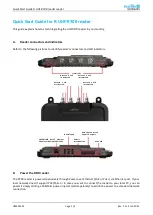
Digital electronic modules
3.2 Parameters of the Digital Electronic Modules
ET 200S
3-6
Manual, Edition 10/2005, A5E00514527-01
Note
If you set pulse stretching for an input channel, this also affects the flutter monitoring
enabled for this channel. The "pulse stretched" signal is the input signal for flutter monitoring.
You should therefore adapt the pulse stretching parameters and flutter monitoring functions
to each other. Select appropriate parameter values in order to tune the functions to your
process.
3.2.5
Chatter monitoring
Definition
Chatter monitoring is a process control function for digital input signals. It detects and reports
signal characteristics that are unusual from a process engineering viewpoint, such as the
input signal fluctuating too frequently between "0" and "1". If signal characteristics like these
occur, it is a sign that the sensors are faulty or that there are instabilities from a process
engineering viewpoint.
Activating chatter monitoring
You activate chatter monitoring by setting the number of signal changes for chatter
monitoring to a value other than zero.
Detecting unusual signal patterns
Each input channel has a monitoring window that has been assigned parameters. The
monitoring window is started the first time the input signal changes. If the input signal
changes more within the monitoring window than the configured number of signal changes,
this is recognized as a flutter error. If a flutter error is not detected within the monitoring
window, the monitoring window is started again at the next signal change.
Reporting a chatter error
If a chatter error has occurred, the current signal status is entered in the process image and
the value of the signal is set to "invalid". A chatter error is also entered as diagnostic
information, triggering an incoming diagnostic interrupt.
You must evaluate and process the status of the value and the diagnostic information in the
user program.
Resetting a chatter error
If no further chattering of the input signal is detected within three monitoring windows, the
diagnostic entry is removed and an outgoing diagnostic interrupt is triggered. The status of
the value of the current signal in the process image is set to "valid".
















































